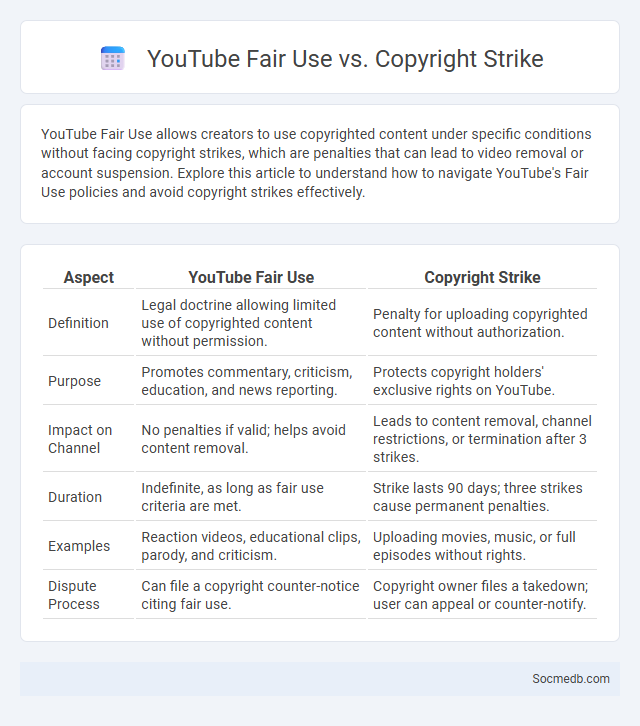
Photo illustration: YouTube Fair Use vs Copyright Strike
YouTube Fair Use allows creators to use copyrighted content under specific conditions without facing copyright strikes, which are penalties that can lead to video removal or account suspension. Explore this article to understand how to navigate YouTube's Fair Use policies and avoid copyright strikes effectively.
Table of Comparison
| Aspect | YouTube Fair Use | Copyright Strike |
|---|---|---|
| Definition | Legal doctrine allowing limited use of copyrighted content without permission. | Penalty for uploading copyrighted content without authorization. |
| Purpose | Promotes commentary, criticism, education, and news reporting. | Protects copyright holders' exclusive rights on YouTube. |
| Impact on Channel | No penalties if valid; helps avoid content removal. | Leads to content removal, channel restrictions, or termination after 3 strikes. |
| Duration | Indefinite, as long as fair use criteria are met. | Strike lasts 90 days; three strikes cause permanent penalties. |
| Examples | Reaction videos, educational clips, parody, and criticism. | Uploading movies, music, or full episodes without rights. |
| Dispute Process | Can file a copyright counter-notice citing fair use. | Copyright owner files a takedown; user can appeal or counter-notify. |
Understanding YouTube Fair Use: An Overview
Understanding YouTube Fair Use is essential for content creators to avoid copyright strikes and legal issues. Fair Use allows limited use of copyrighted material for purposes like commentary, criticism, or education, provided it doesn't harm the original creator's market. Protecting Your channel involves evaluating factors such as purpose, amount used, and effect on the original work's value to ensure compliance with YouTube's policies.
Defining Copyright Strike on YouTube
A copyright strike on YouTube occurs when a content creator uploads material that infringes on copyrighted works without authorization, leading to a formal notification from the copyright owner. This strike impacts the creator's account by imposing restrictions such as video removal, loss of monetization, and potential account suspension if multiple strikes accumulate. YouTube's Content ID system and manual copyright claims are primary mechanisms for detecting and enforcing copyright strikes against unauthorized uploads.
Difference Between Fair Use and Copyright Infringement
Fair use allows limited use of copyrighted content on social media for purposes like commentary, criticism, or education, without permission from the copyright holder. Copyright infringement occurs when protected content is used without authorization, causing potential legal consequences and removal of posts by platforms such as Facebook, Instagram, and YouTube. Understanding fair use factors--purpose, nature, amount, and market effect--helps creators avoid unlawful use and maintain compliance with digital copyright policies.
The Process of Copyright Strikes on YouTube
YouTube's copyright strike process begins when a copyright owner submits a formal complaint through YouTube's Content ID system or manual takedown request. Once a strike is issued, the video is removed, and the channel receives a strike that limits certain features and may lead to termination after three strikes within 90 days. Creators can dispute strikes if they believe their content falls under fair use, is licensed, or they have permission, with YouTube reviewing the dispute to determine if the strike should be removed.
How YouTube Handles Fair Use Claims
YouTube manages Fair Use claims through its Content ID system, which automatically scans uploaded videos for copyrighted material and allows rights holders to claim or monetize content. Creators can dispute claims by submitting a fair use rationale, emphasizing transformative content, commentary, or educational purposes, which YouTube reviews manually. This process balances copyright enforcement with protections for users under the Fair Use doctrine, ensuring lawful content remains accessible.
Common Misconceptions About Fair Use
Common misconceptions about fair use on social media include the belief that all content shared publicly is free to use without permission or that credit alone protects against copyright infringement. Your assumption that fair use automatically applies to reposting videos or images ignores factors like purpose, nature, amount, and impact on the market value of the original work. Understanding these nuances helps you prevent legal issues and respect creators' rights while sharing content online.
Consequences of Receiving a Copyright Strike
Receiving a copyright strike on social media platforms such as YouTube or Instagram can result in content removal, channel suspension, or even permanent account termination. These strikes negatively impact creator monetization opportunities and reduce visibility through algorithmic penalties. Repeated offenses escalate consequences, making it essential to understand copyright policies and implement proper content usage to avoid legal and financial repercussions.
Protecting Your Content: Tips for Creators
Creators can protect their social media content by using watermarks, disabling right-click downloads, and regularly monitoring for unauthorized use. Employing copyright registration and leveraging platform-specific reporting tools enhances content security. Consistent documentation and legal advice help safeguard creative assets from infringement and misuse.
Disputing Copyright Strikes: A Step-by-Step Guide
Disputing copyright strikes on social media requires a clear understanding of platform-specific policies and submitting a detailed counter-notification that challenges the claim effectively. Your dispute should include evidence proving ownership or fair use, such as licenses, permission letters, or metadata supporting your content's originality. Following this step-by-step guide ensures your appeal is processed efficiently, minimizing the risk of account penalties or content removal.
Future Trends in YouTube Copyright and Fair Use Policies
Future trends in YouTube copyright and fair use policies emphasize enhanced AI-driven content recognition to improve accuracy in detecting infringements while minimizing false claims. YouTube is likely to implement more transparent dispute resolution processes and introduce adaptive algorithms that consider context, such as transformative use and educational intent, aligning with evolving fair use standards. These developments aim to balance creators' rights with user freedoms, fostering a fairer digital content ecosystem.
 socmedb.com
socmedb.com